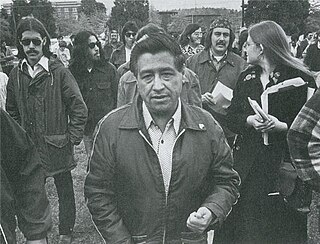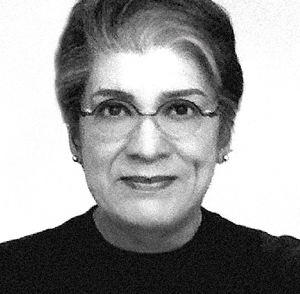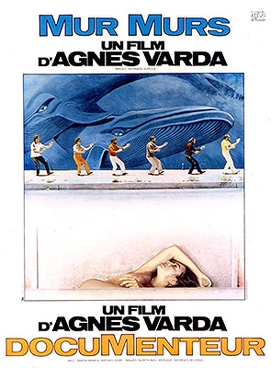
Chicano or Chicana is an ethnic identity for Mexican Americans who have a non-Anglo self-image, embracing their Mexican Native ancestry. Chicano was originally a classist and racist slur used toward low-income Mexicans that was reclaimed in the 1940s among youth who belonged to the Pachuco and Pachuca subculture. In the 1960s, Chicano was widely reclaimed in the building of a movement toward political empowerment, ethnic solidarity, and pride in being of indigenous descent. Chicano developed its own meaning separate from Mexican American identity. Youth in barrios rejected cultural assimilation into whiteness and embraced their own identity and worldview as a form of empowerment and resistance. The community forged an independent political and cultural movement, sometimes working alongside the Black power movement.

Gronk, born Glugio Nicandro, is a Chicano painter, printmaker, and performance artist. His work is collected by museums around the country including the Smithsonian American Art Museum.

The Chicano Movement, also referred to as El Movimiento, was a social and political movement in the United States that worked to embrace a Chicano/a identity and worldview that combated structural racism, encouraged cultural revitalization, and achieved community empowerment by rejecting assimilation. Chicanos also expressed solidarity and defined their culture through the development of Chicano art during El Movimiento, and stood firm in preserving their religion.

Los Four was a Chicano artist collective active based in Los Angeles, California. The group was instrumental in bringing the Chicano art movement to the attention of the mainstream art world.

The East Los Angeles Walkouts or Chicano Blowouts were a series of 1968 protests by Chicano students against unequal conditions in Los Angeles Unified School District high schools. The first walkout occurred on March 5, 1968. The students who organized and carried out the protests were primarily concerned with the quality of their education. This movement, which involved thousands of students in the Los Angeles area, was identified as "the first major mass protest against racism undertaken by Mexican-Americans in the history of the United States".

Self-Help Graphics & Art, Inc. is a community arts center in East Los Angeles, California, United States. The building is a mix Beaux-Arts and vernacular architecture built in 1927, and was designed by Postle & Postle. Formed during the cultural renaissance that accompanied the Chicano Movement, or Self Help, as it is sometimes called, was one of the primary centers that incubated the nascent Chicano art movement, and remains important in the Chicano art movement, as well as in the greater Los Angeles community, today. SHG also hosts musical and other performances, and organizes Los Angeles's annual Day of the Dead festivities. Throughout its history, the organization has worked with well-known artists in the Los Angeles area such as Los Four and the East Los Streetscapers, but it has focused primarily on training and giving exposure to young and new artists, many of whom have gone on to national and international prominence.

The Williams College Museum of Art (WCMA) is a college-affiliated art museum in Williamstown, Massachusetts. It is located on the Williams College campus, close to the Massachusetts Museum of Contemporary Art and the Clark Art Institute. Its growing collection encompasses more than 14,000 works, with particular strengths in contemporary art, photography, prints, and Indian painting. The museum is free and open to the public.

The UCLA Chicano Studies Research Center (CSRC) was founded in 1969 to foster multidisciplinary research efforts at the University of California, Los Angeles (UCLA). It is one of four ethnic studies centers established at UCLA that year, all of which were the first in the nation and have advanced our understanding of the essential contributions of people of color to U.S. history, thought, and culture. The centers remain the major organized research units in the University of California system that focus on ethnic and racial communities and contribute to the system's research mission.
Diane Gamboa has been producing, exhibiting and curating visual art in Southern California since the 1980s. She has also been involved art education, ranging from after-school programs to college and university teaching. Gamboa has been "one of the most active cultural producers in the Chicana art movement in Los Angeles." She actively developed the Chicano School of Painting.

East Los Streetscapers Public Art Studios is a muralist art collective and fine art studio based in East Los Angeles, California. Its members have executed over twenty murals and large-scale public artworks, primarily in the Los Angeles area.

Judithe Hernández is an American artist and educator, she is known as a muralist, pastel artist, and painter. She is a pioneer of the Chicano art movement and a former member of the art collective Los Four. She is based in Los Angeles, California and previously lived in Chicago.
Patssi Valdez is an American Chicana artist. She is a founding member of the art collective Asco. Valdez's work represents some of the finest Chicana avant-garde expressionism which includes but not limited to painting, sculpture and fashion design. She lives and works in Los Angeles, California.
Willie Herrón III is an American Chicano muralist, performance artist and commercial artist.

Asco was an East Los Angeles based Chicano artist collective, active from 1972 to 1987. Asco adopted its name as a collective in 1973, making a direct reference to the word's significance in Spanish ("asco"), which is disgust or repulsion. Asco's work throughout 1970s and 1980s responded specifically to socioeconomic and political problems surrounding the Chicano community in the United States, as well the Vietnam War. Harry Gamboa Jr., Glugio "Gronk" Nicandro, Willie Herrón and Patssi Valdez form the core members of the group.
Yreina Cervantez is an American artist and Chicana activist who is known for her multimedia painting, murals, and printmaking. She has exhibited nationally and internationally, and her work is in the permanent collections of the Smithsonian American Art Museum, The Mexican Museum, the Los Angeles County Museum, and the Los Angeles Museum of Contemporary Art.

Chicano Art: Resistance and Affirmation was a traveling exhibit of Chicano/a artists which toured the United States from 1990 through 1993. CARA visited ten major cities and featured over 128 individual works by about 180 different Chicano/a artists. The show was also intended to visit Madrid and Mexico City. CARA was the first time a Chicano exhibit received major attention from the press and it was the first exhibit that collaborated between Chicanos and major museums in the U.S. The show was considered a "notable event in the development of Chicano art." Another unique feature of CARA was the "extensive planning" that attempted to be as inclusive as possible and which took place more than five years prior to the opening at Wight Art Gallery.

Mur Murs is a 1981 documentary film directed by Agnès Varda. The film explores the murals of Los Angeles, California.
Edmundo Meza, also known as Mundo Meza, was an artist and activist who was born in Tijuana, Mexico and grew up in East Los Angeles. He discovered his passion for the area's avant-garde culture in early 1970. As an emerging artist, Mundo Meza worked for shoe designer Fred Slatten on Santa Monica Boulevard as a window dresser. He also painted unique designs onto Slatten's platform shoes, gathering a celebrity clientele which included Cher, Elton John, and Diana Ross.

The Cheech Marin Center for Chicano Art & Culture, known as The Cheech, is a museum in Riverside, California. It is part of the larger Riverside Art Museum. The center is focused on the exhibition and study of Chicano art from across the United States. This is a collaborative effort between Cheech Marin, the City of Riverside and Riverside Art Museum. Cheech Marin is a stand-up comedian, actor, writer, and collector. He has donated or promised his collection of more than 700 pieces of Chicano art. Riverside provides the old Riverside public library to house the collection and the Riverside Art Museum manages the center. The Cheech strives to be a world-class institution for the research and study of "all things [related to] Chicano art". It is the first North American museum facility dedicated exclusively to Mexican-American and Chicano art.
The Queer Chicano art scene emerged from Los Angeles during the late 1960s and early 1990s composing of queer Mexican American artists. The scene’s activity included motives and themes relating to political activism, social justice, and identity. The movement was influenced by the respective movements of gay liberation, Chicano civil rights, and women’s liberation. The social and political conditions impacting Chicano communities as well as queer people, including the HIV/AIDS epidemic, are conveyed in the scene’s expressive work.









